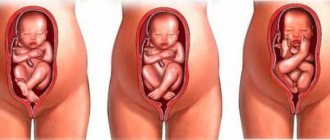What is intrauterine fetal hypoxia
Intrauterine fetal hypoxia is an extremely dangerous condition in which oxygen starvation occurs in the baby while still in the mother’s womb. In most cases, this pathology occurs as a result of other abnormal processes that are associated with the health of the mother or child, as well as during the pathological course of pregnancy. Hypoxia threatens the development of dangerous complications, the severity of which depends on the duration and frequency of oxygen starvation.
Every woman planning a pregnancy or who is in an excellent position should know what factors can provoke pathology, why it is dangerous and how to recognize it. This will save the life and health of yourself and your unborn baby. The pathology occurs in 15% of pregnant women and can be diagnosed at any stage of pregnancy. There are several forms of hypoxia depending on the speed of development of the pathology:
- Fulminant - occurs within a few hours and leads to the development of complications, often fatal.
- Acute - in most cases it develops during childbirth and can last for several hours.
- Subacute – occurs a few days before childbirth, which is due to physiological changes in the functioning of the female body.
- Chronic fetal hypoxia is the most common form of oxygen starvation, which can be provoked by many factors: severe toxicosis or gestosis, the development of intrauterine infection, Rh conflict between mother and child, etc.
Causes of fetal hypoxia
Various factors can provoke intrauterine fetal hypoxia. The most common cause is placental insufficiency, which results in disruption of the blood circulation between the mother, placenta and baby. Insufficient supply of oxygen and nutrients provokes the development of hypoxia.
Other causes of fetal hypoxia include:
- Toxicosis or gestosis (late degree of toxicosis in acute form).
- Entanglement of the fetus with the umbilical cord, which disrupts the blood flow process.
- Placenta previa, which completely or partially blocks the exit from the uterine cavity. This pathology often causes the development of pathology during childbirth, and therefore requires a cesarean section.
- Post-term pregnancy, as a result of which the placenta completely fails to cope with its functional duties, as the process of aging occurs.
- Development of intrauterine infections.
- Severe intoxication of the mother or fetus.
- Congenital or genetic pathologies of child development.
- The mother has pathologies that complicate the course of pregnancy - pulmonary or heart failure, diabetes mellitus, obesity, anemia, etc.
- Incorrect presentation of the fetus or its large size, which makes it difficult to pass through the birth canal.
- Premature aging or placental abruption, uterine rupture.
- Pathologies that occur during childbirth, for example, weak labor.
Diagnostics
Particular attention should be paid to the problem of possible hypoxia in pregnant women with chronic diseases that are at risk. Early diagnosis contributes to the success of therapeutic measures.
Listening with a stethoscope is the classic traditional method for assessing the fetal heartbeat. An experienced doctor will evaluate the frequency, rhythm, sonority of tones, and noises. But given modern research methods, this is too approximate. Its error is plus or minus 10-15 heartbeats.
An ultrasound sensor attached to the mother's abdomen listens to the heartbeat and analyzes its parameters - this is cardiotocography. The result is printed on paper and analyzed by a specialist.
Blood flow in the vessels of the mother, fetus, and umbilical cord is measured by the Doppler method. This study allows us to determine the degree of development of hypoxia and predict the course of further development of the fetus.
In addition to these methods of diagnosing hypoxia, a non-stress test, determination of the biophysical profile of the fetus, ECG, and biochemical and hormonal blood tests of the mother are used.
When labor approaches, the amniotic fluid is examined for the presence of meconium in it: fecal feces. The delivery tactics will depend on the results obtained.
Symptoms of fetal hypoxia
In order to determine the development of intrauterine fetal hypoxia, it is necessary to carefully monitor the “behavior” of the baby. At the initial stage of oxygen starvation, the child shows increased activity and anxiety, frequent and sudden movements are felt. Any mother who listens to her feelings and her baby will immediately notice changes.
In the absence of help and prolonged persistence of hypoxia, the fetus does not receive the required amount of oxygen, as a result of which its activity decreases, the tremors become rare and weak. In some cases, the baby’s movement in the womb is not felt at all.
You should immediately contact a gynecologist if physical activity has decreased to 3 kicks per hour or the baby’s movements are not felt for several hours.
How to determine fetal hypoxia
In order to promptly detect fetal hypoxia, it is necessary to monitor its motor activity. For this purpose, it is recommended to keep a “movement diary”, noting how many tremors the pregnant woman felt over a certain period of time. During a visit to the gynecologist, the doctor regularly listens to the heartbeat, determining its rhythm and clarity of tones.
If symptoms indicating intrauterine oxygen deprivation appear, you should immediately consult a doctor. After a visual examination and listening to the heartbeat, the gynecologist will prescribe additional diagnostic procedures:
- CTG – assessment of the fetal heartbeat and physical activity. Special sensors are attached to the pregnant woman’s belly, and a cardiac monitor records basic data about the baby’s condition. Assessing the fetal heart rate and activity allows you to assess its general condition and determine whether oxygen starvation is occurring.
- Ultrasound with Doppler - allows you to assess the condition of the fetus and analyze blood flow in the placenta. This diagnostic method will help identify congenital or genetic anomalies, developmental defects and other problems.
- Amniocentesis is performed if there is a suspicion of intrauterine infection or severe intoxication.
Hypoxia during childbirth
During normal labor, each uterine contraction (contraction) causes a temporary decrease in blood flow to the placenta. Such short-term hypoxia is well tolerated by a healthy fetus, and after the uterus relaxes, the blood supply to the fetus is restored in full.
If the duration of oxygen starvation during childbirth is increased, then the blood supply to the fetus is sharply disrupted. Changes begin in the internal organs. If at this time the baby is not born, then his death may occur at the time of birth or immediately after it.
Causes of fetal hypoxia during childbirth
Signs of fetal hypoxia during labor
- fast or too slow heartbeat
- decrease or cessation of fetal movements
- green amniotic fluid (meconium contamination)
Signs of newborn asphyxia (stopping oxygen supply)
Hypoxia in newborns is usually called asphyxia, and its degree (moderate or severe) is determined using the Apgar scale in the first and fifth minutes after birth.
Maintaining 0-3 points on the Apgar scale for 5 minutes or more means severe asphyxia.
- convulsions
- oliguria and anuria
- aspiration (inhalation) of meconium
- necrotizing enterocolitis (death of part of the intestine).
Signs of newborn asphyxia (stopping oxygen supply)
Maintaining 0-3 Apgar scores for 5 minutes or more
Disorders of the brain and other organs:
- convulsions
- oliguria and anuria
- aspiration (inhalation) of meconium
Previously, it was believed that a baby could only inhale original feces (meconium) during childbirth. There is now evidence that even with chronic hypoxia there is a risk of meconium aspiration. Moreover, the removal of original feces from the lungs in the second case brings less results, and among the consequences there are disorders of the nervous system and frequent pneumonia.
- DIC (blood clotting disorder)
- necrotizing enterocolitis (death of part of the intestine)
Signs of hypoxic-ischemic encephalopathy
- delayed spontaneous movements after birth
- convulsions
- impaired consciousness
- low muscle tone
- Irregular breathing with stops or complete absence of spontaneous breathing
All these changes occur in the first three days after birth. If symptoms appear later, an infection or other complication is likely the cause.
It is important to remember that hypoxia is often associated with the development of cerebral palsy in a child. This scenario is possible, but not required. Most children who have suffered perinatal hypoxia do not suffer from this serious disease.
Treatment of fetal hypoxia
Treatment of oxygen starvation depends on its form and duration. So, in case of acute hypoxia, emergency delivery is performed by caesarean section.
The following methods are used to treat chronic oxygen starvation:
- Elimination of the cause that provoked hypoxia (treatment of infection, fight against gestosis and toxicosis, etc.).
- Normalization of uteroplacental blood flow. In most cases, Actovegin or Curantil is used for this purpose.
- Ensuring complete physical and moral peace for the pregnant woman. Sedatives are often prescribed - valerian extract, motherwort infusion, etc.
- Dilation of blood vessels in the uterine area, which improves blood flow. No-shpa and Eufillin are used for this.
- Reducing uterine tone with Magne-B6 and Ginipral.
- To improve metabolism, special medications are prescribed - Essentiale, Hofitol, etc.
- Neuroprotectors and antihypoxants will help increase the fetus' resistance to hypoxia.
If there is no positive dynamics in treatment, an emergency caesarean section is performed if the gestational age is more than 28 weeks.
Intrauterine fetal hypoxia can provoke the development of a number of complications:
- Delayed physical development of the fetus.
- Cerebral palsy.
- Anomalies and pathologies of child development.
- The emergence of neurological pathologies.
- Death of the fetus.
What are the consequences of hypoxia in a child?
Chronic and acute oxygen starvation can have the same consequences, but they are somewhat different. For example, in the acute form of the disorder, the risk of brain cell death increases, then treatment will no longer help and emergency surgery will be required. In the chronic form, deviations are more often observed after the birth of the child.
Prolonged fetal hypoxia, consequences without treatment:
- failure of organ formation during intrauterine development;
- disruption of embryo development, early damage to the central nervous system;
- inability of the fetus to develop in the womb;
- deviation of physical development.
After birth, the child will have problems with nutrition, the lack of appetite will be long-lasting, so the weight will also decrease. Treatment depends on the form of the deviation, but more often therapy is prescribed to normalize the function of the central nervous system.
In acute hypoxia, the nutrition of brain cells is disrupted and they die. A child may be born disabled, or high-quality treatment can rehabilitate the baby and he will grow up absolutely healthy. Making a forecast in advance is problematic even for the most experienced specialists.
Prevention of fetal hypoxia
In order to prevent the development of intrauterine fetal hypoxia and avoid possible complications, it is necessary to follow the simple recommendations of obstetricians and gynecologists:
- Carefully plan and prepare for pregnancy. First of all, it is important to treat all infectious diseases, put chronic diseases into remission and undergo a full physical examination, which is recommended for both partners.
- Regularly visit a gynecologist to monitor the progress of pregnancy, fetal development and the woman’s condition.
- Maintaining a healthy lifestyle - proper nutrition, walks in the fresh air, moderate physical activity, giving up bad habits.
- Providing the pregnant woman with adequate rest.
- Regular monitoring of the motor activity of the fetus and mandatory consultation with a gynecologist if its behavior changes.
- Choosing the right method of delivery. So, if there are indications for a cesarean section (placenta previa or abnormal fetal position), you should not refuse it.
Following simple preventive measures will help avoid fetal hypoxia. Paying close attention to yourself and listening to your feelings will allow you to give birth to a healthy baby.











